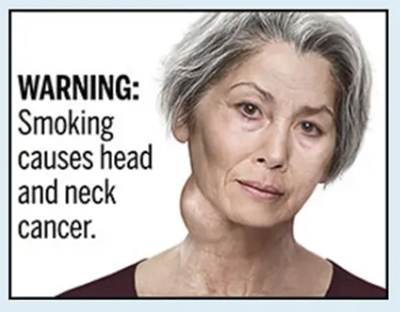Cigarette Warnings – Info-creep to package takeover
In 1965, a simple verbal declaration on cigarette packages noted “CAUTION: Cigarette Smoking May Be Hazardous to Your Health.” Four years later, the “Caution” was upgraded to an outright: “WARNING: The  Surgeon General Has Determined That Cigarette Smoking Is Dangerous to Your Health.”
Surgeon General Has Determined That Cigarette Smoking Is Dangerous to Your Health.”
In 1984, Congress enacted the Comprehensive Smoking Education Act, requiring labeling stating one of four “Surgeon General Warnings:
- Smoking Causes Lung Cancer, Heart Disease, Emphysema And May Complicate Pregnancy.
- Quitting Smoking Now Greatly Reduces Serious Risks to Your Health.
- Smoking By Pregnant Women May Result in Fetal Injury, Premature Birth, and Low Birth Weight.
- Cigarette Smoke Contains Carbon Monoxide
But it became clear that these warnings weren’t curbing tobacco use – especially by adolescents. Various initiatives (such as restricting flavored and menthol-containing cigarettes) were instituted, but even those weren’t enough to accomplish Congress’s stated goal of “restrict[ing] advertising and marketing of tobacco products….”
Hence, in 2009, Congress passed the Family Smoking Prevention and Tobacco Control Act (“TCA” or “Act”), augmenting previous directives by selecting nine specific package warnings that would rotate quarterly.
- WARNING: Cigarettes are addictive.
- WARNING: Tobacco smoke can harm your children
- WARNING: Cigarettes cause fatal lung disease.
- WARNING: Cigarettes cause cancer.
- WARNING: Cigarettes cause strokes and heart disease.
- WARNING: Smoking during pregnancy can harm your baby.
- WARNING: Smoking can kill you.
- WARNING: Tobacco smoke causes fatal lung disease in nonsmokers.
- WARNING: Quitting smoking now greatly reduces serious risks to your health.
But increasing text and font size wasn’t enough—Congress also wanted graphic images to accompany these textual warnings. The powerful graphic warnings were also mandated to occupy half the visual real estate of each cigarette package's front and back panels and 20% of advertising material.
“Modernizing the ubiquitous text of the Surgeon General’s current warnings, the Act requires cigarette packages to include ‘color graphics depicting the negative health consequences of smoking to accompany the [updated] label statements.’ …”
In 2012, the Cigarette companies sued, claiming the TCA was unconstitutional. The 6th Circuit ruled against them, holding the Act did not impinge on freedom of speech. The Supreme Court declined to hear their appeal.
However, in a separate case, the FDA was challenged regarding how the Rule would be implemented. This time, they lost, although the ruling only applied to the specific proposed warnings and graphics, not the constitutionality of the underlying TCA. In 2013, the FDA promised to promulgate new rules and graphic warnings – a promise that stood empty for almost a decade.
By 2016, the FDA, failing to issue the promised new rules, was sued by the American Cancer Society, and other groups sued to force compliance with the TCA. In 2018, Massachusetts’s District Court’s Judge Indira Talwani gave the FDA until March 2020 to promulgate final rules and new warnings. The new rules, delayed by COVID-19, didn’t emerge until 2021.
Within a month, the tobacco companies sued, decrying the warnings as “unprecedented” and “precisely the type of compelled speech that the First Amendment prohibits” and alleging that each warning “misrepresent[s] or exaggerate[s] the potential effects of smoking.”
In December of 2022, a Texas court agreed. The decision was appealed to the traditionally arch-conservative 5th Circuit, which, in late March, rendered its decision. [1]
The Tobacco Companies Claim a Word is Worth a Thousand Pictures
Among the cigarette companies’ objections was that graphic depictions couldn’t accurately represent what text can. The 5th Circuit didn’t buy that. A second argument the companies claimed was that the visceral or emotional response evoked by the images trespassed on their First Amendment rights. The Court didn’t buy that either. The Court was operating on the Zauderer standard, which focuses on preventing consumer deception and requires that only facts, not opinions, be put before the consumer. In ruling that the graphics and the warnings were both accurate and informative, i.e., they were facts and not opinions, the Court decided that:
“Graphic and textual warnings that convey factual information about the health risks of tobacco use are reasonably related to the purpose of preventing consumer deception.… That deception…, arose inherently from the past decades of false advertising and misleading research by the companies that were proclaiming that tobacco had no health risks and was not addictive.”
The Court also determined that while facts can “disconcert, displease, provoke an emotional response, spark controversy, and even overwhelm reason, … that does not magically turn such facts into opinions.” Because they were ‘purely factual and uncontroversial’ information” even if the images “could be misinterpreted by consumers” or were “primarily intended to evoke an emotional response, or, at most, shock the viewer into retaining the information in the text warning,” the primary purpose was to inform consumers.
“Emotional response to a statement is irrelevant to its truth; the emotional impact of the Warnings does not abrogate their factual nature.”
As for the package’s “real estate” takeover, the Court found the number and size of required warnings and graphics weren’t unduly burdensome.
Holding that the warnings are both factual and uncontroversial, the 5th Circuit overruled the lower district court and determined the Act to be constitutional, but the FDA didn’t get an outright win. The Court sent the matter back to determine if the FDA complied with all the procedural rule-making requirements. Likely, they will succeed.
Hopefully, once instituted, these warnings will reduce cigarette consumption and prove a public health boon.
Warning: Beyond the Lines
The Court’s language -- which might be considered dicta (the incidental expression of opinion, not essential to the decision nor setting a precedent), may bode poorly for anti-science groups, such as the anti-vax contingent. The Court goes to great lengths to differentiate between scientific fact, information, and opinion, distinguishing scientific facts from “truth.” It is not inconceivable, for example, that this case might be used to compel social media to include a warning regarding the lack of scientific veracity of some anti-vax claims.
In determining that “factual information” requires it to be falsifiable material and inferences fairly drawn from it, rather than one’s non-falsifiable interpretations, the Court rejects non-falsifiable “opinions,” e.g., harms attributed to vaccines, such as contemporaneous implantation of tracking devices, causing infertility, and the like.
While acknowledging that “in some instances, compulsion to speak may be as violative of the First Amendment as prohibitions on speech” and that no State may “prescribe what shall be orthodox in politics, nationalism, religion, or other matters of opinion or force citizens to confess by word or act their faith therein,” they held that this sentiment does not apply to scientific facts
To pass muster, a warning, even accompanied by a graphic, must comply with the Zauderer requirements. In addition to furthering a governmental interest and not being unduly burdensome, the warnings must be:
- statements composed of only information supported by facts,
- conclusions driven by those facts
- not akin to unfalsifiable statements of opinion.
“Consequences supported by scientific findings, even if exaggerated or non-modal, are still, by definition, factual…”
Information contained in a medical textbook, the court notes, would be considered factual. A science-based position, even one aligned with a particular political party, won’t shield it if it is not factual, holds the Court, rejecting the plaintiff's claim that “the Rule is unlawful because it conveys an ideological or provocative message. “
The Court concludes: “A fact does not become “value-laden” merely because the fact drives a reaction. But even if it did, ideological baggage has no relevance to the first Zauderer prong. Any number of factual messages are, of course, ideological… In other words, that the speaker does not like the message does not make it controversial; there must be something more.”
The Fifth Circuit's ruling, affirms the constitutionality of government action compelling graphic warnings on cigarette packages, dismisses claims of freedom of speech violations, and endorses government speech as a public health tool. By adhering to the Zauderer standard, which prioritizes factual scientific fact over opinion, the decision sets a precedent for addressing other public health challenges and combating public health misinformation that might see far-reaching uses.
[1] For now, the US falls short of its international peers in warning prowess, currently ranking last in the world in the size of warnings, and well behind in implementing graphic warnings, now required by 138 countries and territories. Cigarette-related illness costs Americans some 300 billion dollars a year -- which continues while the tobacco companies and the FDA duke it out, as the tortured history of the TCA reveals.
Sources: Defending Graphic Warnings on Cigarette Packs and Ads American Cancer Society




